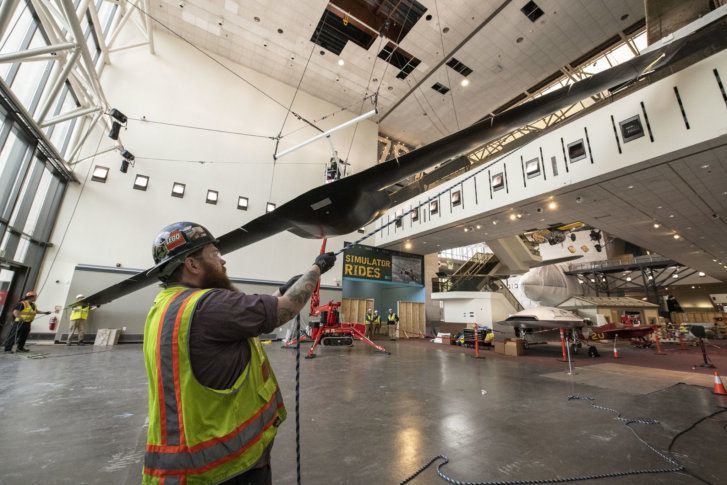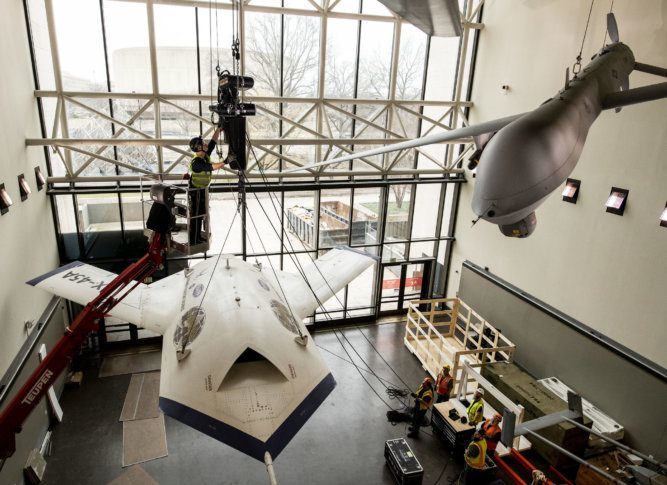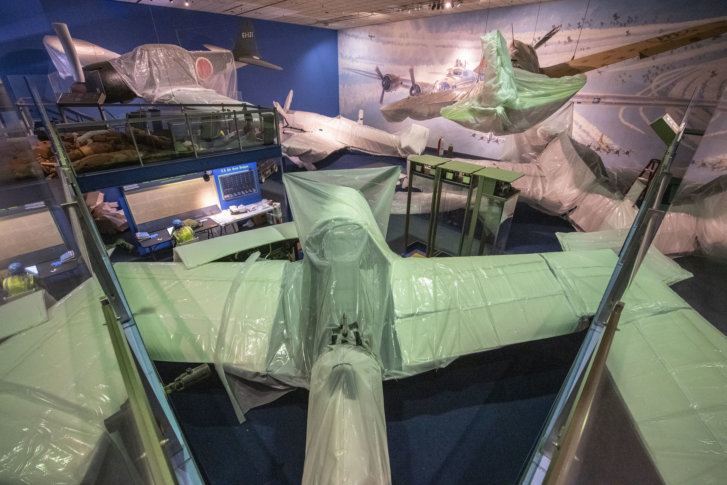-
The Lockheed Martin/Boeing RQ-3A DarkStar aircraft is lowered in the Military Unmanned Aerial Vehicles exhibit during west end renovation of the National Air and Space Museum in Washington, D.C., March 7, 2019. (Smithsonian photo by Jim Preston/Courtesy Smithsonian’s National Air and Space Museum)
-
Museum Specialist Jamile Shirley, left, consults with a co-worker on the phone about packing U.S. Navy Capt. W.T. Hardacker’s World War II flying suit, as contractor Sam Block stands by in the Sea-Air gallery of the National Air and Space Museum as renovation begins in the East end of the museum in Washington, D.C., Jan. 30, 2019. (Smithsonian photo by Jim Preston/Courtesy Smithsonian’s National Air and Space Museum)
-
The Lockheed Martin/Boeing RQ-3A DarkStar drone is lowered in the Military Unmanned Aerial Vehicles exhibit during west end renovation of the National Air and Space Museum in Washington, D.C., March 7, 2019. (Smithsonian photo by Mark Avino/Courtesy Smithsonian’s National Air and Space Museum)
-
National Air and Space Museum staff and contractors from iWeiss; Century Aviation; and Crozier Fine Arts, work to lower the Lockheed U-2C aircraft hanging in the closed Looking at Earth Gallery of the National Air and Space Museum in Washington, D.C., Feb. 15, 2019. (Smithsonian Photo by Mark Avino/ Courtesy Smithsonian’s National Air and Space Museum)
-
-
The right wing is unbolted and separated from the fuselage of the Lockheed U-2 aircraft after it was lowered from the ceiling in the closed Looking at Earth gallery in the National Air and Space Museum in Washington, D.C., Feb. 19 2019. (Smithsonian photo by Jim Preston/Courtesy Smithsonian’s National Air and Space Museum)
-
The forward fuselage of the Lockheed U-2 aircraft is moved by staff and contractors out of the closed Looking at Earth gallery of the National Air and Space Museum in Washington, D.C., Feb. 25, 2019. (Smithsonian photo by Jim Preston/Courtesy Smithsonian’s National Air and Space Museum)
-
Contractors from Crozier Fine Arts work to protect in place the Hellcat aircraft in the closed Sea-Air Operations gallery as part of the renovation underway at the National Air and Space Museum in Washington, D.C., Feb. 19, 2019. (Smithsonian photo by Jim Preston/Courtesy Smithsonian’s National Air and Space Museum)
-
Contractors from iWeiss work to rig the X-45A drone for lowering in the Military Unmanned Aerial Vehicles (UAV) Gallery of the National Air and Space Museum in Washington, D.C., Feb. 22, 2019. (Smithsonian photo by Jim Preston/Courtesy Smithsonian’s National Air and Space Museum)
-
-
Aircraft are wrapped for protection before stage one demolition in the closed World War II Gallery in the National Air and Space Museum in Washington, D.C., March 5, 2019. (Smithsonian photo by Jim Preston/Courtesy Smithsonian’s National Air and Space Museum)
-
Items in display cases are labeled before being removed and carefully packed in the closed Jet Aviation gallery of the Smithsonian Air and Space museum in Washington, D.C., Feb. 12, 2019. (Smithsonian photo by Jim Preston/Courtesy Smithsonian’s National Air and Space Museum)
-
The tail section and main fuselage of the Lockheed U-2 aircraft sit on racks after being lowered from the ceiling in the closed Looking at Earth gallery in the National Air and Space Museum in Washington, D.C., Feb. 19, 2019. (Smithsonian photo by Jim Preston/Courtesy Smithsonian’s National Air and Space Museum)
-
Revitalization work in the closed off America by Air gallery of the Smithsonian Air and Space museum in Washington, D.C., Feb. 12, 2019. (Smithsonian photo by Jim Preston/ Courtesy Smithsonian’s National Air and Space Museum)
-
-
National Air and Space Museum staff and contractors from iWeiss; Century Aviation; and Crozier Fine Arts, work to lower the De Havilland DH-4 aircraft in the closed Looking at Earth gallery of the National Air and Space Museum in Washington, D.C., Feb. 12, 2019. (Smithsonian photo by Jim Preston/Courtesy Smithsonian’s National Air and Space Museum)
For the renovation, nearly every artifact in the museum will be packed up and moved out, with the exception of a few items, including the nose of a Boeing 747 and Charles Lindbergh’s Spirit of St. Louis, which will be protected in place. Most of the other aircraft and spacecraft will be lowered, dismantled, wrapped, and transported on a truck to a climate-controlled storage facility at the museum’s
Steven F. Udvar-Hazy Center in Chantilly, Virginia.
“All of this is done extremely carefully, extremely well documented,” said Stofan, a former NASA chief scientist who has been leading the museum for about a year.
“You’re dealing with artifacts, some of which are 50, 60, 70 years old that maybe actually weren’t meant to last for hundreds of years, but we’ve got to make them last that long.”
Giant F-1 engines that powered the Saturn V rocket to the moon also need to relocate from one side of the museum to the other — “and they are extremely heavy,” Stofan added.
“Some of the artifacts were put into this museum with a crane when it was being built and they haven’t really been moved since. And all the sudden we’re saying, ‘How did they get this in here? And how did they move it around?’”
Currently, the museum’s west wing is closed, and after a few years, work will move to the east side of the building. But Stofan said just because a few galleries are temporarily unavailable, doesn’t mean locals and tourists should cancel their plans to visit. The Air and Space Museum has a number of special exhibits open and events planned throughout the year — especially in the summer to celebrate the 50th anniversary of Apollo’s moon landing.
And while seven years may seem like a long time for a building renovation, Stofan said it will all be worth it in the end — and for decades to come.
“We’re going to be telling the story of: Where are we going in space flight? Are we going back to the moon, going on to Mars? How is aviation changing? Are we really going to go to flying cars?” Stofan said.
“How do we inspire this next generation that’s going to move this country forward in aviation, in space, in this increasingly technological society that we have? I want those kids to come in here and be truly inspired.”
The first set of renovated galleries at the Air and Space Museum is scheduled to open in 2022.


















